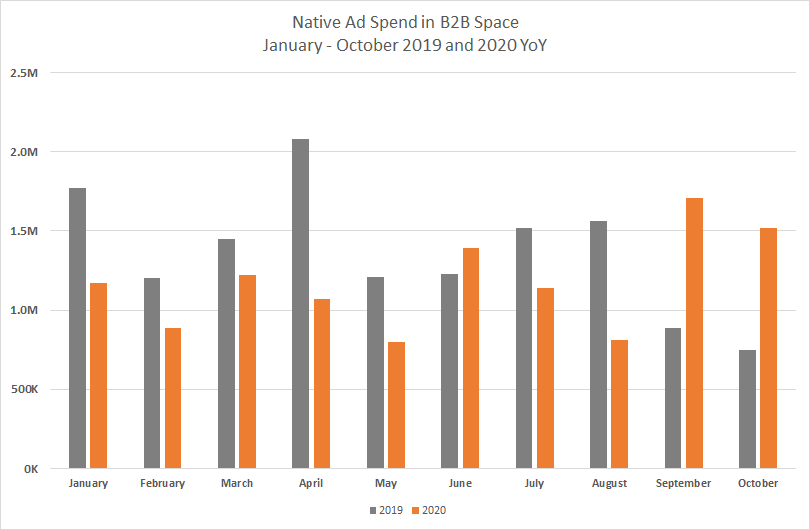Without the presence of events, many B2B companies are experimenting with new ways of advertising this year.
One medium that has attracted B2B brands is native advertising. Native ads have the look and feel of the media format in which they appear, but are actually paid ads.
COVID-19 changed everything for brands, including their approach to native advertising. Here, we look at the behaviors of the top B2B native advertisers and how spending stacks up against last year.
We encourage you to subscribe to our blog for the latest data surrounding the advertising industry. We will provide daily updates as COVID-19 continues to make its mark on the US economy.

Why B2B Brands Look To Native Ad Space
Native advertising isn’t new, but it did present a fairly safe format for brands to advertise in this year, with new layers of opportunity considering surging online traffic.
Native is a safe bet
The very nature of native advertising tends to make it more acceptable for audiences to digest. It’s simply less disruptive—just another image on a LinkedIn feed or an article on a publishing site.
Audiences usually know that the content is advertorial, but don’t mind. A 2018 Stanford University study showed that even though audiences recognize an ad for what it is, native ads are still effective because they lead to higher exposure. Native advertising is about building a brand and letting audiences become more familiar with them over time.
Native advertising isn’t as flexible or as highly targeted as, say, programmatic advertising, but it is relevant for audiences and good for spreading awareness.
It’s a good time to take advantage of online activity
Though physical magazines are struggling during the pandemic without offices, online magazines experienced a surge of traffic, presenting good opportunities for native ads.
That doesn’t mean finding sponsors for online content didn’t come without challenges.
“There’s a surge of interest around news, so we saw huge tides of increased traffic in certain categories, but not necessarily the categories that people surround with sponsorships, so that’s always a challenge,” said Alison Overholt, senior VP of multiplatform storytelling and journalism at ESPN. “How do you match up the spots where you’ve got rising traffic and engagement with the sponsorship support?”
In response to this mismatch between topics of interest and business-friendly categories, a shift took place. Publications shifted content and brands that were more needed in a pandemic and economic recession started investing more in this medium (i.e. producing more content about business security, and in turn drawing more IT sponsors).
MediaRadar Insights
Methodology
This analysis looks at the behaviors of the top B2B native advertisers in January through October of 2020 and compares that activity to the same period in 2019.
Findings
Native advertising has seen a decrease in ad dollars—but not as significantly as other popular B2B mediums (i.e. events and print).

Both the number of advertisers and advertising spend decreased year-over-year (YoY) compared to the time period between January and October.
From January through October of 2019, there were 6,500 native advertisers spending $13.7 million. From January through October of 2020, there were 6,400 native advertisers spending $11.7 million.
Overall spend fell 14% YoY, and the number of brands fell 2%. This means that roughly the same number of brands is buying ads. They are just spending less.
Note: At the beginning of 2020, even before COVID-19 hit, fewer B2B brands were buying native ads. And they were spending less too. In January, the number of brands was down by 5% and spend was down by 34% YoY.
Additionally, 4,200 of the 6,400 brands (66%) that used native advertising this year did not spend in the native B2B space in 2019. Together, they accounted for $3.1 million (or 27%) of the spend. Though there is the same amount of B2B brands advertising using this medium, the majority of brands are new to this format and spend less than returning brands.
Returning brands sustained large native ad campaigns: the top ten brands in 2020 accounted for 38% of the total ad spend. These brands are:
- VMWare, inc.
- Morgan Stanley
- BP America
- Tokyo Metropolitan Government
- Cisco Systems
- Dashlane
- TaxAct
- DraftKings Nation
- Kinney Recruiting
- Lawline
None of the top ten spending brands in 2020 overlapped with the top ten spending brands in 2019—which is reflective of the massive changes brought on by the pandemic.
The biggest spenders—VMWare and Morgan Stanley—alone accounted for 25% of the total ad buy from January through October.
VMWare is a desktop virtualization software, and spent 15% of the total ad buy from January through October. However, they only spent from March to April, targeting businesses who needed to allow employees to work from home.
Morgan Stanley wrote content guiding businesses on how to lead and innovate during a crisis. They spent 10% of the total ad buy from January through October. Unlike VMWare, their campaign started in June and has continued through October.
The top five spending categories in 2020 are:
- Tech
- Finance
- Services
- Media
- Industries
Spend in these five categories amounted to 83% of total native ad buy, due in part to brands like VMWare and Morgan Stanley sustaining large campaigns.
As the pandemic continues to affect daily life in much of the US, marketers will have to continue to adjust, deciding how much to spend on native advertising.
For more updates like this, stay tuned. Subscribe to our blog for more updates on coronavirus and its mark on the economy.



